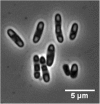Catalytically active inclusion bodies of L-lysine decarboxylase from E. coli for 1,5-diaminopentane production
- PMID: 29643457
- PMCID: PMC5895699
- DOI: 10.1038/s41598-018-24070-2
Catalytically active inclusion bodies of L-lysine decarboxylase from E. coli for 1,5-diaminopentane production
Abstract
Sustainable and eco-efficient alternatives for the production of platform chemicals, fuels and chemical building blocks require the development of stable, reusable and recyclable biocatalysts. Here we present a novel concept for the biocatalytic production of 1,5-diaminopentane (DAP, trivial name: cadaverine) using catalytically active inclusion bodies (CatIBs) of the constitutive L-lysine decarboxylase from E. coli (EcLDCc-CatIBs) to process L-lysine-containing culture supernatants from Corynebacterium glutamicum. EcLDCc-CatIBs can easily be produced in E. coli followed by a simple purification protocol yielding up to 43% dry CatIBs per dry cell weight. The stability and recyclability of EcLDCc-CatIBs was demonstrated in (repetitive) batch experiments starting from L-lysine concentrations of 0.1 M and 1 M. EcLDC-CatIBs exhibited great stability under reaction conditions with an estimated half-life of about 54 h. High conversions to DAP of 87-100% were obtained in 30-60 ml batch reactions using approx. 180-300 mg EcLDCc-CatIBs, respectively. This resulted in DAP titres of up to 88.4 g l-1 and space-time yields of up to 660 gDAP l-1 d-1 per gram dry EcLDCc-CatIBs. The new process for DAP production can therefore compete with the currently best fermentative process as described in the literature.
Conflict of interest statement
The authors declare no competing interests.
Figures







Similar articles
-
Construction and comprehensive characterization of an EcLDCc-CatIB set-varying linkers and aggregation inducing tags.Microb Cell Fact. 2021 Feb 17;20(1):49. doi: 10.1186/s12934-021-01539-w. Microb Cell Fact. 2021. PMID: 33596923 Free PMC article.
-
Characterization of a Whole-Cell Biotransformation Using a Constitutive Lysine Decarboxylase from Escherichia coli for the High-Level Production of Cadaverine from Industrial Grade L-Lysine.Appl Biochem Biotechnol. 2018 Aug;185(4):909-924. doi: 10.1007/s12010-018-2696-4. Epub 2018 Jan 26. Appl Biochem Biotechnol. 2018. PMID: 29374336
-
Systems-wide metabolic pathway engineering in Corynebacterium glutamicum for bio-based production of diaminopentane.Metab Eng. 2010 Jul;12(4):341-51. doi: 10.1016/j.ymben.2010.03.005. Epub 2010 Apr 8. Metab Eng. 2010. PMID: 20381632
-
[Molecular engineering and immobilization of lysine decarboxylase for synthesis of 1, 5-diaminopentane: a review].Sheng Wu Gong Cheng Xue Bao. 2022 Dec 25;38(12):4403-4419. doi: 10.13345/j.cjb.220400. Sheng Wu Gong Cheng Xue Bao. 2022. PMID: 36593185 Review. Chinese.
-
Bio-based production of the platform chemical 1,5-diaminopentane.Appl Microbiol Biotechnol. 2011 Sep;91(5):1287-96. doi: 10.1007/s00253-011-3457-2. Epub 2011 Jul 15. Appl Microbiol Biotechnol. 2011. PMID: 21761208 Review.
Cited by
-
Construction and comprehensive characterization of an EcLDCc-CatIB set-varying linkers and aggregation inducing tags.Microb Cell Fact. 2021 Feb 17;20(1):49. doi: 10.1186/s12934-021-01539-w. Microb Cell Fact. 2021. PMID: 33596923 Free PMC article.
-
The Effect of Visible Light on the Catalytic Activity of PLP-Dependent Enzymes.ChemCatChem. 2021 May 19;13(10):2398-2406. doi: 10.1002/cctc.202100163. Epub 2021 Mar 30. ChemCatChem. 2021. PMID: 34249169 Free PMC article.
-
Synthesis, characterization and crystallization kinetics of a bio-based, heat-resistance nylon 5T/10T.RSC Adv. 2023 Jun 13;13(26):17874-17882. doi: 10.1039/d3ra02337k. eCollection 2023 Jun 9. RSC Adv. 2023. PMID: 37323451 Free PMC article.
-
Building Up Functional Coiled-Coil-Based Supramolecular Assemblies for Biomedical and Biotechnological Applications.Methods Mol Biol. 2025;2870:245-265. doi: 10.1007/978-1-0716-4213-9_13. Methods Mol Biol. 2025. PMID: 39543039
-
Challenges Associated With the Formation of Recombinant Protein Inclusion Bodies in Escherichia coli and Strategies to Address Them for Industrial Applications.Front Bioeng Biotechnol. 2021 Feb 10;9:630551. doi: 10.3389/fbioe.2021.630551. eCollection 2021. Front Bioeng Biotechnol. 2021. PMID: 33644021 Free PMC article. Review.
References
-
- Kriegler E, et al. Fossil-fueled development (SSP5): An energy and resource intensive scenario for the 21st century. Glob. Environ. Chang. 2017;42:297–315. doi: 10.1016/j.gloenvcha.2016.05.015. - DOI
-
- U.S. Energy Information Administration. International Energy Outlook 2016. 0484, (2016).
Publication types
MeSH terms
Substances
LinkOut - more resources
Full Text Sources
Other Literature Sources

